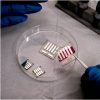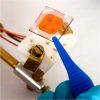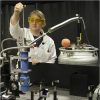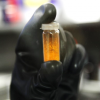We work on a variety of research topics in which we investigate the electronic structure and processes of polymeric and molecular organic semiconductors using optical spectroscopy and measurement on optoelectronic devices. Current projects include the topics listed below.
 Phosphorescent polymer light-emitting diodes (Anna Köhler)
Phosphorescent polymer light-emitting diodes (Anna Köhler)
Efficient organic light-emitting diodes (OLEDs) are typically made by combining different charge transporting materials and phosphorescent materials. By time-resolved photoluminescence studies, Monte-Carlo simulations and OLED measurements, we study the dynamics of excited states in such systems with a view to understanding and improving the energy and charge transfer processes in such OLEDs.
 Excited state dynamics in organic solar cells (Anna Köhler)
Excited state dynamics in organic solar cells (Anna Köhler)
Efficient organic solar cells are often based on a multicomponent structure. At present, very little is known how the photo-excited coulomb bound electron-hole pair separates at the interface between dissimilar organic semiconductor materials. In this study, we use time-resolved spectroscopy to follow the dynamics of excited state formation and dissociation. This is combined with measurements on solar cell structures. An understanding of these issues is essential for the design of efficient solar cells.
 The effect of self-assembly on opto-electronic processes (Anna Köhler)
The effect of self-assembly on opto-electronic processes (Anna Köhler)
Organic semiconductors can be designed to self-assemble into a range of supramolecular structures.In this research area, we study how the optical and electronic properties of such assemblies depend on the nature of the inter-molecular interactions, and how this affects the properties of OLEDs, solar cells and transistors.
 Understanding structure-function relationship in halide perovskites (Fabian Panzer)
Understanding structure-function relationship in halide perovskites (Fabian Panzer)
A main question that we address is how changes in the structure of halide perovskites, be it the crystal structure, material composition or surface morphology impact their electronic structure, especially their optical properties. Due to their soft nature, halide perovskites are prone to changes in their structure, which naturally occur during their crystal growth and film formation, or which we induce for example by changing the temperature or by applying pressure. We use various absorption and photoluminescence measurement techniques, including steady-state, time resolved or in situ during film formation to understand the fundamental correlation between their structure and their optoelectronic properties.
 Innovative processing strategies for halide perovskites (Fabian Panzer)
Innovative processing strategies for halide perovskites (Fabian Panzer)
The currently most important processing routes for the film formation of halide perovskites suffer from a high complexity, as the material synthesis and layer formation are inseparably linked. We thus aim for new processing strategies which can overcome this existing issue. To decouple the perovskite synthesis from its film formation we use readily prepared perovskite powders and process them solvent free via novel spray coating approaches (in collaboration with the Department of Functional Materials) and / or via pressure treatment. With these strategies we want to advance the processing of halide perovskites also in an industrial context, allowing for efficient perovskite based devices such as next generation solar cells or X-Ray detectors.


